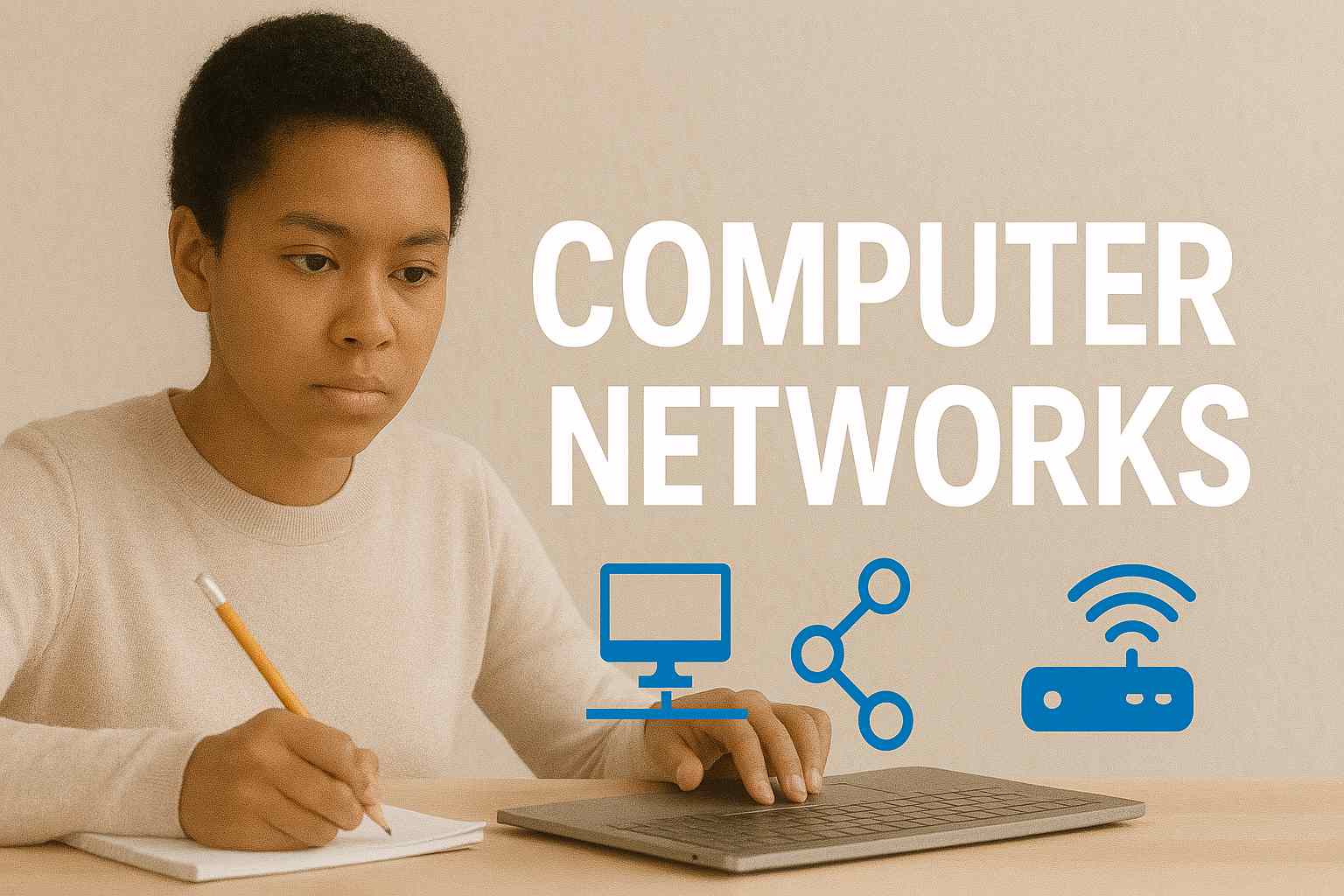
💡 What is a Computer Network?
A computer network is a group of connected devices (computers, phones, servers) that share resources, such as files, internet, printers, or apps.
Key goals of networking:
✅ Communication
✅ File and data sharing
✅ Internet access
✅ Centralized management
✅ Remote access and control
Without networks, the internet, email, social media, and cloud services wouldn’t exist.
Common Network Types
1. Local Area Network (LAN) – Covers small areas like homes, schools, or offices. Example: School computer lab.
2. Wide Area Network (WAN) – Connects cities or countries. The internet is the biggest WAN.
3. Metropolitan Area Network (MAN) – Covers cities or large campuses.
4. Wireless Networks (WLAN) – Uses Wi-Fi instead of cables to connect devices.
5. Personal Area Network (PAN) – Connects devices around one person (e.g., phone + Bluetooth headset).
🔧 Basic Networking Devices
Router – Connects multiple networks and manages traffic. Your home router connects you to the internet.
Switch – Connects devices within a LAN and sends data only where needed.
Modem – Connects your local network to your internet provider.
Access Point – Extends wireless signals.
Firewall – Monitors traffic for security and filters unauthorized access.
🌐 IP Address and DNS
An IP address is a unique number assigned to every device on a network. It’s like a home address for data delivery.
IPv4 uses numbers like 192.168.1.1
IPv6 uses longer codes to support more devices
DNS (Domain Name System) converts website names (like ardiland.com) into IP addresses. It’s like a phonebook for the internet.
🔁 How Data Travels in a Network
Data moves in small units called packets. Each packet includes:
Sender’s IP
Receiver’s IP
Data being sent
Instructions to rebuild it in order
When you visit a site:
Your browser sends a request
DNS converts the domain to an IP
Router sends data to the server
Server responds with a webpage
Your browser displays it
🧩 Important Network Protocols
HTTP/HTTPS – Used for websites
TCP/IP – Core communication protocol of the internet
FTP – Transfers files
SMTP/IMAP – Handles email sending/receiving
DHCP – Assigns IP addresses automatically
DNS – Resolves domain names
VPN – Secures private network access over the internet
Protocols ensure that devices understand and handle data the same way.
🔐 Network Security Essentials
Networks need protection from:
Hackers
Malware
Unauthorized users
Data theft
Common security tools:
Firewalls
Antivirus software
Network segmentation
Encryption (e.g., HTTPS, VPNs)
User authentication and strong passwords
For Ethiopian businesses and government offices, network security is critical to avoid data breaches or attacks.
🔌 Wired vs Wireless Networks
Wired Networks
Faster and more stable
Used in offices and data centers
Requires Ethernet cables
Wireless Networks
More convenient (no cables)
Common in homes, schools, cafes
Depends on signal strength and interference
📚 Real-World Uses of Networking in Ethiopia
✅ Internet cafes and libraries using LAN to share printers
✅ Hospitals using intranets to manage patient data
✅ Schools offering Wi-Fi across campus
✅ Banks using secure private networks to transfer transactions
✅ Homes using routers for internet, streaming, and remote work
💼 Career Roles That Use Networking
IT Support Technician
Network Administrator
Cybersecurity Analyst
System Engineer
Data Center Technician
Telecom Field Engineer
Comments (1)
Categories
Recent posts


Ethiopian Coders Initiative: Free Coding ...
18 Mar 2025
Grade 12 Exam Preparation Ethiopia | ...
18 Mar 2025
How to Make Money Online in Ethiopia | ...
18 Mar 2025





The document provides a comprehensive and well-structured overview of computer networks, effectively outlining their fundamental concepts, types, components, and practical applications. It begins by defining a computer network as an interconnected system of devices that facilitates resource sharing—a concise yet accurate description that sets a strong foundation for the subsequent sections.
The delineation of key networking goals, such as communication, data sharing, and centralized management, underscores the functional importance of networks in modern digital infrastructure. Furthermore, the classification of common network types, including LANs, WANs, and wireless networks—demonstrates a clear understanding of spatial and technological distinctions. At the same time, the inclusion of essential networking devices (routers, switches, firewalls) highlights their operational roles in data transmission and security.
The explanation of IP addressing, DNS, and data packetization is particularly insightful, offering a technical yet accessible breakdown of how information traverses' networks. Additionally, the document appropriately emphasizes network security, acknowledging prevalent threats and mitigation strategies, which is especially relevant for Ethiopian institutions vulnerable to cyber threats. The comparison between wired and wireless networks is balanced, noting trade-offs between speed and convenience, while real-world applications in Ethiopian contexts—such as healthcare, banking, and education—effectively ground theoretical concepts in practical scenarios.
Finally, the mention of career roles related to networking adds vocational relevance, making this document a valuable primer for students, professionals, and organizations seeking to understand or implement networked systems. Overall, the content is informative, logically organized, and tailored to technical and non-technical audiences.